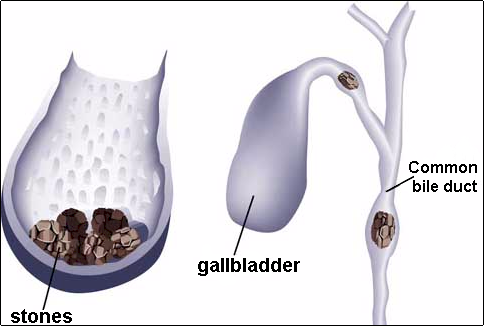


What Are Gallstones?

Gallstones disease is the most common disorder affecting the body's biliary system, the network of organs and ducts that create, transport, store, and release bile. Bile is a thick fluid, made in the liver and stored in the gallbladder, that acts in the small intestine to digest fat. Bile contains cholesterol, water, proteins, bilirubin (a breakdown product from blood cells), bile salts (the chemicals necessary to digest fat), and small amounts of copper or other materials. If the chemical balance of bile contains too much of any of these components, particularly of cholesterol, crystals form and can harden into stones. Learn about tiny stones in your that cause pain... see causes, symptoms, find treatment & removal of Gallstones.
In size, gallstones can be as small as a grain of sand or as large as a golf ball. A person can form one large stone in his or her gallbladder, or hundreds. About 10 percent of the population have gallstones, but the vast majority experience no symptoms and need no treatment. However, in 1 percent to 2 percent of these people, gallstones can cause problems by lodging in bile ducts, stopping the flow of bile or digestive enzymes, and leading to severe abdominal pain, vomiting, inflammation, and even life threatening infection. There are two types of gallstones: cholesterol and pigment stones.
About 80 percent of all gallstones are cholesterol stones, yellow green stones made up of hardened cholesterol. Cholesterol stones are associated with bile that contains an overabundance of cholesterol, or is "supersaturated" with cholesterol. The other 20 percent of gallstones are pigment stones, composed of bilirubin and other elements.
more about Gallstones...
.......
Pigment stones are often seen in Asian cultures but rarely in U.S. patients. They are black or brown in color, and why they occur is not fully understood. Black pigment stones tend to remain in the gallbladder, whereas brown pigment stones often lodge in bile ducts. The prevalence of gallstone disease varies worldwide. High rates occur in the United States, Chile, Sweden, Germany, and Austria. Pima Indian women have among the highest rates of gallstone disease in the world; nearly 70 percent have gallstones by age 30. On the other hand, Asian populations have a low incidence of gallstones, and the Masai people of East Africa have none at all. In the United States, an estimated 10 to 15 percent of adults have gallstone disease.

About a million new cases are diagnosed each year, and some 800,000 operations are performed to treat gallstones, making gallstone disease the most common gastrointestinal disorder requiring hospitalization. The medical cost of gallstones in the United States is estimated to be about $5 billion yearly. The primary therapy for gallstones that are causing pain, inflammation, or infection is removal of the gallbladder.







